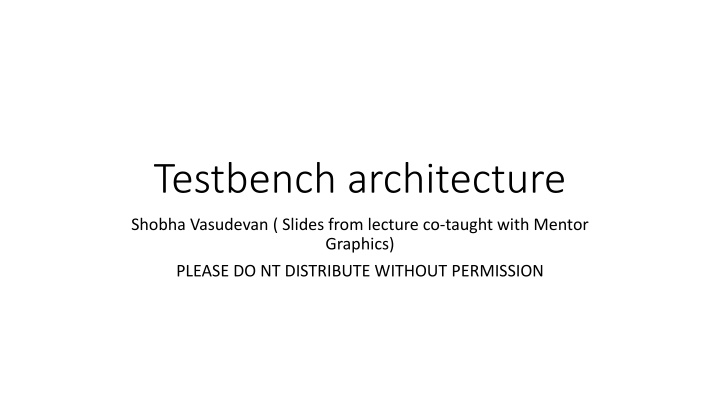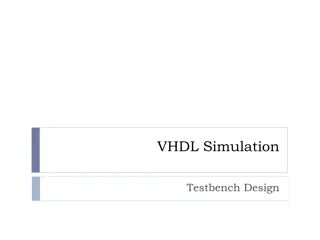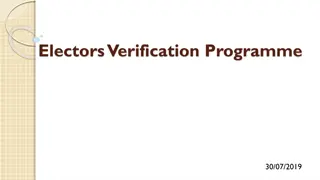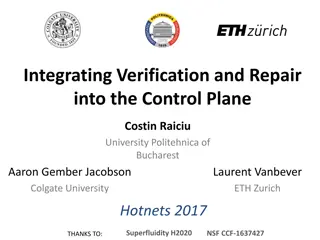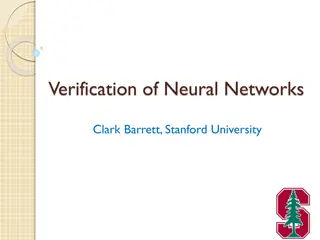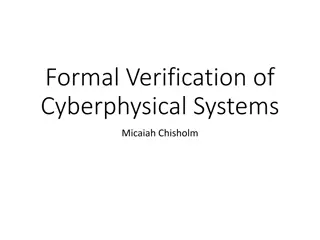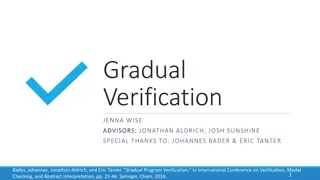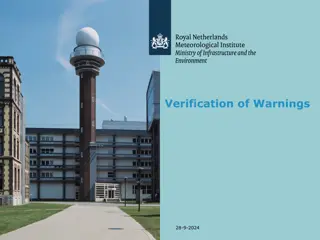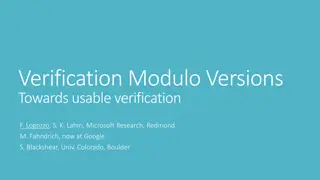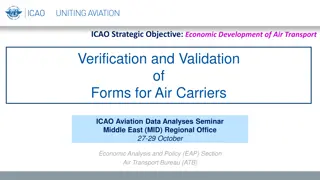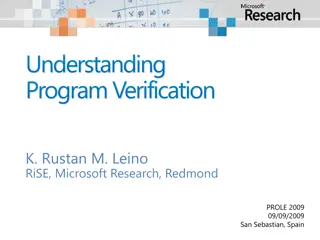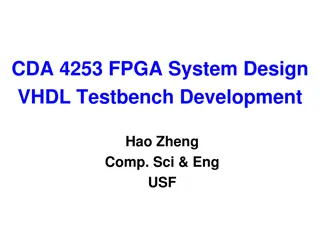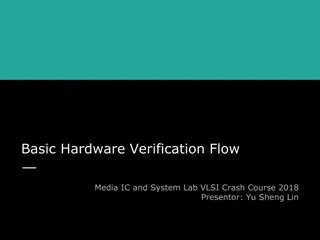Testbench Architecture for Verification Planning
This presentation provides insights into the evolution of Hardware Verification Languages (HVLs) and the development of the Open Verification Methodology (OVM). It covers the essential concepts of OVM, its benefits, and its compatibility with different simulators. The OVM serves as a unified class library and methodology for VIP interoperability, incorporating best practices from over a decade of experience in advanced verification methodologies.
Uploaded on Mar 16, 2025 | 1 Views
Download Presentation

Please find below an Image/Link to download the presentation.
The content on the website is provided AS IS for your information and personal use only. It may not be sold, licensed, or shared on other websites without obtaining consent from the author.If you encounter any issues during the download, it is possible that the publisher has removed the file from their server.
You are allowed to download the files provided on this website for personal or commercial use, subject to the condition that they are used lawfully. All files are the property of their respective owners.
The content on the website is provided AS IS for your information and personal use only. It may not be sold, licensed, or shared on other websites without obtaining consent from the author.
E N D
Presentation Transcript
Testbench architecture Shobha Vasudevan ( Slides from lecture co-taught with Mentor Graphics) PLEASE DO NT DISTRIBUTE WITHOUT PERMISSION
Agenda Verification Planning Testbench Architecture Testbench Implementation SystemVerilog Basics OOP with SystemVerilog OVM Introduction Le xm ark , Ju ne 2
Evolution of HVLs Growing volume of Ecosystem products and services OVM 1.0 released as open source eRM URM OVM 1.1 update OVM 2.0.1 update AVM Q1 2009 Jan 9 2002 2005 Spring 2007 May 7 August 2007 Sept 2008 Oct 2008 OVM 2.0 OVM Users guide Unified sequences TLM enhancements Other capabilities More capabilities to come!! OVM announced: R&D teams demonstrate OVM will run on both Mentor and Cadence simulators
What is OVM? Open Written in IEEE 1800 SystemVerilog Runs on any simulator supporting the IEEE 1800 standard Verified on Mentor Graphics Questa and Cadence s Incisive Verification Platforms True open-source license agreement (Apache 2.0) Interoperable Ensures VIP interoperability across ecosystem & simulators Enables VIP plug and play functionality for designers Ensures interoperability with other high level languages Proven Based on Mentor s Advanced Verification Methodology (AVM) and Cadence s Incisive URM methodology Incorporates best practices from >10 years of experience
OVM = AVM + URM OVM OVM is a superset of both the AVM and URM Open, unified class library and methodology for interoperable VIP Cadence s Incisive Plan-to- Closure (IPCM) URM and Mentor s Advanced Verification Methodology (AVM) Project-to-Project Reuse Block-to-System Reuse Coverage-Driven Environment Configuration Incremental Adoption Multi-Layered Sequences TLM Communication Common Messaging OVM enables backward compatibility with AVM 3.0 & URM 6.2 Mentor & Cadence committed to collaborative development of OVM
OVM = AVM + URM AVM forms the backbone of the OVM OVM TLM Communication Constrained-Random & Sequential Stimulus Functional Coverage Greatest Flexibility for Modularity & Reuse Environment Configuration Incremental Adoption AVM AVM URM URM TLM Communication Constrained-Random Stimulus Functional Coverage Modularity & Reuse Incremental Adoption Incremental Adoption TLM Communication Constrained-Random Stimulus Functional Coverage Modularity & Reuse TLM Communication Sequential Stimulus Specification UVC Encapsulation Strategy Environment Configuration Configuration TLM Communication Sequential Stimulus Specification UVC Encapsulation Strategy Environment
What is the news? The first truly open, interoperable, and proven verification methodology based on the SystemVerilog IEEE 1800 language Jointly developed by Cadence and Mentor Graphics Delivers simulator, VIP, and high level language interoperability across companies and ecosystem Scalable to system level
OVM Benefits Open Written in IEEE 1800 SystemVerilog Runs on any simulator supporting the IEEE 1800 standard Verified on Cadence s Incisive and Mentor Graphics Questa Verification Platform True open-source license agreement (Apache 2.0) Interoperable Ensures VIP interoperability across ecosystem & simulators Enables VIP plug and play functionality for designers Ensures interoperability with other high level languages Proven Based on Cadence s Incisive Plan-to-Closure URM module and Mentor s Advanced Verification Methodology (AVM) Incorporates Best Practices from >10 years of experiences
OVM Description OVM Class Library uses SystemVerilog language and runs on any compliant simulator Provides building blocks (objects) for verification environment Common set of low-level utilities VIP and Verification Environment OVM Methodology (documentation, examples, code snippets) OVM Class Library OVM Methodology Framework to create VIP Guidelines for how to use the class library SystemVerilog Language IEEE 1800 Compliant Simulator
OVM Documentation OVM Reference Guide Documents all ovm classes, methods and macros in the OVM library OVM User Guide OVM Overview Transaction Level Modeling Developing Reusable Verification Components Assembling Tests and Testbenches Advanced Topics Phasing Factory & Overrides Sequence Control & Protocol Layering Detailed description of Xbus example
OVM Concepts: Overview Test/Testbench Separation Improves reusability Test customizes testbench Flexible Component Instantiation Test can override testbench Configurability Test controls Structural, run-time parameters Allows greater topological flexibility Hierarchical Sequential Stimulus Simplified Test Writer interface Decouple stimulus from component hierarchy TLM Communication Improves component modularity Enables plug-n-play reuse Test Env(Testbench) Component2 Component VC VC VC VC
OVM: Combine SystemVerilog and TLM to build a true, reusable methodology Vertical Reuse From block to system in a single project Horizontal Reuse Reuse of modules, libraries across projects Platform Reuse Reuse of testbenches, assertions etc, across the tools A A Testbench B B Project A A B Project B Verification IP, Methodology A B RTL Simulation TLM Modeling Emulation A Testbench B 12
A Layered Approach to Verification Analysis Testbench-Specific Operational Test Design-Specific Transactors Coverage Coverage (Config) Protocol-Specific Stimulus/ Master Slave TLM DUT Stimulus Generator / Master Abstractor Slave Abstractor Transaction-Level interfaces
A Layered Approach to Verification Analysis Testbench-Specific Operational Test Design-Specific Transactors Coverage Scoreboard Coverage (Config) Protocol-Specific Stimulus/ Master Slave Monitor Monitor Stimulus Generator / Master Abstractor Driver DUT Responder Slave Abstractor Pin-Level interfaces Transaction-Level interfaces Assertions
OVM Concepts: Separation Separate architectural details from end-user Testcase customizes testbench environment Instantiate and configure the environment Components within that env. Tests are short, clear and descriptive Easy to maintain Changes are done in a central location Test and environment can be derived Build a base classes Testcases Derivatives change stimuli kinds, negative testing etc. Environments Topology for TLM, RTL connections etc. Testcases Test Env(Testbench) Env1(Testbench) Env2(Testbench) Env3(Testbench) Env4(Testbench)
OVM Concepts: Phasing Built-in phases handle the basics All phases run in-order User can define additional phases Can be inserted anywhere in the list Automatically run in order Instantiate top-level env Build/config components Define connections Resolve bindings Configure components Execute test (run task) Gather information Check results Report results new build Construction Elaboration connect end_of_elaboration start_of_simulation run extract check report Simulation Report
class my_env extends ovm_env; A u1; B u2; Phased Build Process Don t actually use new Don t actually use new Don t actually use new (discussed later) function new(string name, ovm_component parent); super.new(name, parent); endfunction function void build(); super.build(); u1 = new( u1 ,this); u2 = new( u2 ,this); u2.build(); endfunction function void connect(); u1.p.connect(u2.e); endfunction class A extends ovm_component;//u1 C u3, u4; function void build(); super.build(); u3 = new( u3 ,this); u4 = new( u4 ,this); endfunction function void connect(); ... endfunction class B extends ovm_component;//u2 D u5, u6; function void build(); super.build(); u5 = new( u5 ,this); u6 = new( u6 ,this); u6.build(); endfunction function void connect(); ... endfunction u3 u4 u5 u6
Transaction-Level Modeling (TLM) TLM is all about communication through interfaces A TLM port specifies the API to be used A TLM export supplies the implementation of the methods Connections are between ports/exports, not components Transactions are objects Components with the same interfaces can be swapped transparently No changes to parent connect() Analysis ports/exports support 1:many write() calls Write to scoreboard/collector class my_trans extends ovm_transaction; endclass my_env analysis_export analysis_export Coverage Coverage ovm_analysis_port ovm_put_port Request ovm_put_export ovm_get_export Response ovm_get_port Initiator Target1 Target2 function void connect(); i.p_port.connect(t.p_xport); i.g_port.connect(t.g_xport); t.a_port.connect(c.analysis_export); t.a_port.connect(c2.analysis_export); endfunction
OVM Concepts: Configuration Configure anything Modal configuration Change modes of operation by changing values of variables E.g. debug verbosity Topological configuration Changes variables to modify the topology E.g. Verification environment Manual configuration Sets and gets the configuration manually Automated configuration Set the configuration manually Gets the configuration via the build phases class test; ... set_config_int( block , num_d ,2); set_config_int( *.d* , errinj ,1); ... class block_env; bit num_d = 1; driver d[0:num_d-1]; set_config_int( d0 , delay ,5); get_config_int( num_d ,num_d); if(num_d == 2) set_config_int( d1 , active ,0); class driver; bit active = 1; bit delay = 2; bit errinj = 0; bit errinj = 0; bit errinj = 1; class driver; bit active = 0; int delay = 2; int delay = 2; class driver; bit active = 0; class driver; bit active = 1, errinj = 0; int delay = 2; function void build(); super.build(); get_config_int( active ,active); get_config_int( delay ,delay); get_config_int( errinj ,errinj); class driver; bit active = 1, errinj = 0; int delay = 2; function void build(); super.build(); get_config_int( active ,active); get_config_int( delay ,delay); get_config_int( errinj ,errinj); class driver; bit active = 1; int delay = 2; bit errinj = 0; bit errinj = 0; bit errinj = 1; class driver; bit active = 1; int delay = 5; int delay = 5; class driver; bit active = 1;
Running a Test Built-in phased execution flow is launched by calling ovm_env::run_test(string test_name = ) Runs test specified by function argument if provided, unless overridden by command line plusarg +OVM_TESTNAME= Elaboration, simulation and report (sub-)phases are executed in predefined order Each phase invokes a function or task with the same name run() is the only phase task Each phase is executed for every component Bottom-up or top-down run() and pre_run() for threaded components only
Managing Shutdown Test Static method global_stop_request() Spawns stop() task in all participating components Waits for all stop() tasks to complete Components register for stop management enable_stop_interrupt = 1; override stop() task Global stop timeout Each component should have its own timeout as well Global stop usually managed from base test class my_env extends ovm_env; A u1; B u2; task run(); ... global_stop_request(); // on to extract() phase endtask class my_env extends ovm_env; A u1; B u2; class A; task run(); ... ms = 1; endtask task stop(); wait(ms == 1); endtask endclass class B; task run(); ... -> st_ev; endtask task stop(); fork begin @st_ev; wait(st==IDLE); end # stop_time; join_any disable fork; endtask endclass
What are sequences? What are sequences Parallel tasks that arbitrate for access to a driver Sequence Task() Sequence Driver Sequencer Get(req); Do_op Put(rsp); DUT Task() Sequence arbitration Task() Transaction-level RTL-level
Why Use Sequences? Encapsulation and Modularity of Stimulus Generation Separation of Structure from Behavior Parallel Stimulus Layering Protocols packet -> cell, multi-word -> single-word, translations Flexible Stimulus Control injection of noise, gaps, errors control ratios of stimulus types Reuse of Stimulus sequences for specific RTL blocks (i.e. configuration) encapsulation of functions ability to hand stimulus block to other project
Operations Sequences Create transactions (sequence_item) Request access, send item to driver Optionally get a response back Sequencer an arbitrating fifo Queue requests from sequences Wait for request from driver Arbitrate and choose sequence, send item Route response back to sequence Driver Get request, do operation, put response
Sequence Overview A sequence requests for the driver When granted, the sequence specifies the operation to do The sequencer sends the operation from the sequence to the driver The driver executes the operation The driver optionally sends the response back to the sequence Sequencer Driver Sequence loop get(operation); send_to_dut; put(response); end Body() loop apply_operation(); end end DUT Arbitrate
Sequential Stimulus OVM A sequencehas a method that generates a stream of transactions or other sequences trans DUT The sequencer provides transactions from the sequence to the driver Sequencer Driver
Sequential Stimulus OVM The sequencer has a default sequence that it executes A sequence can spawn another sequence Each sequence attempts to execute an item in the sequence arb trans Sequencer Sequencer Driver The sequencer arbitrates between multiple sequences
Sequential Stimulus OVM A lower-level sequence processes the pkt-level item into a set of cell items A lower-level item may request a higher-level item arb Pkt cell cell Cell Driver Upper Sequencer Lower Sequencer
Sequences Decouple stimulus specification from structural hierarchy Add/remove/modify stimulus scenarios independent of testbench Simplify test writer API Sequences define transaction streams s1.start(u1); fork s2.start(u1); s3.start(u1); join Sequences can call children function void s5::body(); s1.start(u1,this); fork s2.start(u1,this); s3.start(u1,this); join s4.start(u1,this); Built-in get_response() task Sequences & transactions customizable via the factory u1 u1 u1 May start on any sequencer s1 s1 Optional parent sequence s5 s3 s2 s4
Sequential Stimulus Sequence calls wait_for_grant() Sequencer waits for get() arbitrates and grants access Transaction is randomized Sequence calls send_request(req) Sequence optionally calls get_response(rsp) A sequence may request a transaction from another (higher-level) sequencer u2 just sees a driver Sequence/Sequencer Driver Driver does get(req) Performs bus cycle Driver optionally does put(rsp) rsp.set_id_info(req); u1 s1 u2 s3 s2
Sequences Sequences are objects Sequences have a virtual method body() to specify the behavior Executes items procedurally Can contain other code Can spawn other sequences Can call other sequences Can use all SV constructs class my_seq extends ovm_sequence; ... virtual task body(); logic [31:0] first_addr,next_addr; read_count = 5; for (int i=0; i<read_count; i++) begin `ovm_do_with(txn, {txn.trtype == WRITE32;}) first_addr = txn.addr; `ovm_do_with(txn, {txn.addr == first_addr && txn.trtype == READ32;}) start(parallel_seq); `ovm_do(sub_seq); end randsequence() ... endtask ...
Hierarchy and Elaboration The OVM has structural base classes to aid hierarchy, elaboration and simulation ovm_component Base unit of structural hierarchy Provides hierarchical naming Provides access to the (TLM) connectivity infrastructure connect() method Provides a run() task And associated kill(), suspend() and resume() methods Provides reporting facilities ovm_env Derived fromovm_component to add sequence of pre-defined simulation phases Including connect() and run() methods Contains and manages all class based testbench components Constructs, connects and configures the testbench ovm_test Also derived fromovm_component Optional for encapsulating environment customizations
OVM Component Hierarchy ovm_test extends ovm_component; // Customizes the environment // Defines stop criteria ovm_env extends ovm_component; // Manages phasing // Encapsulates structural testbench ovm_component; // Basic unit of structural hierarchy
Integrated Reporting Infrastructure Provides utilities for consistent report handling Features: Severities with one or more associated actions Severities: message, warning, error, fatal Actions: display, log, count, exit, no action, call hook Filtering By unique or common string ids By numeric verbosity level By component instance and hierarchy Log files Redirection to multiple output files
Modularity + Configurability & analysis Env defines topology & configures components Number & type of components Default stimulus sequence(s) Encapsulate components for reuse Packages Reuse components in new env Additional stimulus & analysis Test customizes env Choose env from library Coordinate Stimulus Additional tweaking Test instantiated by top-level module Test chosen from library The Basics: driver, monitor, stimulus top test test env env
OVM Summary True Multi-Vendor Support Out-of-the-box, fully tested and supported Architected for Reuse Component/environment reuse TLM-based components use standard interfaces Test modifies testbench components and topology Components control instantiation and configuration Separate stimulus from testbench hierarchy Simplified Test API Sequential stimulus independent of testbench Test defines Component types and configuration settings Stimulus to run on which components Test writer does not need to know full OOP details of testbench test testbench d e
